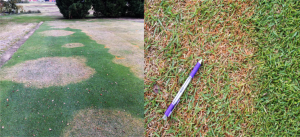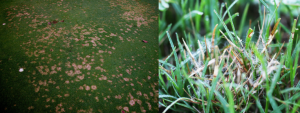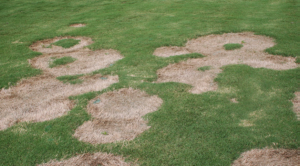Author: Alfredo Martinez-Espinoza, Plant Pathology Department, University of Georgia-Griffin Campus
Large patch: To limit the severity of Rhizoctonia large patch on warm season grasses (especially on zoysiagrass), avoid nitrogen applications at this time. Regardless of fertility, preventive fungicide treatments may be required. The fungus (Rhizoctonia solani) becomes active when night temperatures fall below 60°F. Fungicides of the chemical groups carboxamides, benzimidazoles, carbamates, dicarboximides, DMI fungicides, di-nitro anilines, nitriles, polyoxins, and Qo inhibitors applied in late September or early October provide LP control (see the most recent Georgia Pest Management Handbook or visit https://caes2.caes.uga.edu/commodities/turfgrass/georgiaturf/Publicat/1640_Recommendations.htm for a complete list of fungicides labeled for large patch). There is myriad of fungicides labeled for large patch but in tests in our UGA filed trials; fluoxapyroxad (Xzemplar) at 0.26 fl oz per 1000 sq ft; fluoxapyroxad + pyraclostrobin (Lexicon) at 0.47 fl oz per 1000 sq ft; tebuconazole (Mirage) at 1.0 fl oz/1000 sq ft; penthiopyrad (Velista) 0.5 or 0.7 oz/1000 sq ft; trifloxastrobin + triadimefon (Armada) 1.5 fl oz/1000 sq ft; azoxystrobin + propiconazole (Headway) at 1.5 fl oz/1000 sq ft; provided significant (a<0.05) large patch suppression. Depending on weather conditions, 1 or 2 fall applications can suppress disease to the point where spring treatments may not be required. Apply the fungicides in at least 2 (preferably 3) gallons of water per 1000 sq.ft. Do not water fungicides in. Other management strategies include: Making sure that areas are well-draining, as moisture levels in the thatch and soil is an essential aspect of large patch management; Preventing and/or alleviating soil compaction; Mowing at the recommended height for the turfgrass species.

Photo: Alfredo Martinez
For more information
https://extension.uga.edu/publications/detail.html?number=C1088
Dollar spot: On cool season turfgrasses, dollar spot is usually most severe from September through December. It is important to use preventive control at this time of year. Curative control often fails in fall and winter because turf recovery is reduced by short day length and cold temperatures (particularly at night). Dollar spots that develop in late fall and winter can take weeks to heal, regardless of how much fungicide is applied. Therefore, consider a preventive fungicide program rather than curative. There are many fungicides that will provide excellent control of dollar spot – check the labels for information. To reduce the risk of fungicide resistance (we have some resistant dollar spot in GA) avoid repeated use of fungicides that are considered ‘high risk’ for resistance (DMI’s, dicarboximides, benzimidazoles, etc.). These products provide excellent, long-term control of dollar spot, but applications should be rotated among chemical groups and/or alternated with ‘limited risk’ materials (e.g. fungicides that contain chlorothalonil). Cultural practices for dollar spot prevention include: Monitoring fertility through light and frequent nitrogen applications, which are recommended for disease management and maintenance of turfgrass growth. Irrigating before sunrise, or otherwise avoiding irrigating in the late afternoon or evening, as this prolongs periods of leaf wetness. Removing thatch layers if they are greater than 1 inch in depth as it serves as inoculum reservoir.

Photo: Alfredo Martinez
Comprehensive information on identification and control on dollar spot can be found at https://extension.uga.edu/publications/detail.html?number=C1091
Spring Dead Spot: From early October to early November is the time for SDS prevention in Georgia. Table below contains a list of Spring Dead Spot labeled fungicides. Some fungicide products are golf courses only. Check the label. Cultural practices that improve the cold-hardiness of bermudagrass can be particularly effective for managing SDS. Proper use of nitrogen fertilizers is important because high nitrogen levels can reduce the winter hardiness of bermudagrass. A neutral to slightly alkaline soil pH has been linked to increased SDS severity. Maintain soil pH at 5.8 to 6.2. Use acid-forming fertilizers on sites with near neutral to alkaline pH. Apply iron, manganese and other micronutrients based on soil test results. Any soil condition that reduces bermudagrass root growth such as compaction, excessive thatch (> ½ in) and poor drainage can also increase the severity of SDS.

Photo: Alfredo Martinez
Comprehensive information on identification and control of SDS can be found at https://extension.uga.edu/publications/detail.html?number=C1012
| FUNGICIDES FOR SDS | RATES (oz/1000 sq ft) |
| azoxystrobin
Heritage TL, Strobe 50 WG, Strobe 2L ArmorTech Zoxy |
0.4 oz at 28 day intervals 0.38-0.77 oz at 28 days |
| azoxystrobin + acibenzolar-S-methyl Heritage Action | 0.4 oz at 28 day intervals 0.2-0.4 oz at 14-28 day |
| azoxystrobin + propiconazole
Headway |
3 oz at 14-28 day intervals |
| azoxystrobin+tebuconazole
ZoxyT, Strobe T |
1.5 oz at 14-28 day intervals |
| chlorothalonil + thiophanate methyl +
iprodione + tebuconazole Enclave |
3-4 fl oz at 14-21 day intervals 7-8 fl oz at 28 day |
| fluoxastrobin
Disarm 480 SC, G, Fame SC Fungicide, Fame G Fungicide |
0.36 fl oz at 28 day intervals
2.3-4.6 lb at 14-28 day intervals |
| fluoxastrobin + chlorothalonil
Disarm C, Fame + C |
5.9 oz at 14-28 day intervals |
| fluoxastrobin + myclobutanil
Disarm M |
0.5-1 oz at 14-28 day intervals |
| fluoxastrobin + tebuconazole
Fame + T |
0.45-0.9 oz at 21-28 day intervals |
| fluxapyroxad + pyraclostrobin
Lexicon |
0.47 fl oz |
| isofetamid
Kabuto |
Program A: 3.2 fl oz preventative. Single application.
Program B: First application 0.5-2 fl oz; second application 0.5-1.2 fl oz at 14-28 day interval |
| isofetamid + tebuconazole
Tekken |
3.0 fl oz |
| myclobutanil
ArmorTech Myclo 20EW, Eagle 20EW, Eagle WSP 40, Golden Eagle |
2.4 fl oz at 28 day intervals |
| PCNB + tebuconazole
Oreon |
6-8 fl oz at 28 day intervals |
| penthiopyrad
Velista |
|
| propiconazole
ArmorTech PPZ143MC Banner Maxx, Banner GL Kestrel, Monsoon turf, ProPensity 1.3ME, Prophesy, Propiconazole SPC 14.3 Propicure 3.6F Savvi, Spectator Strider |
4 oz at 30 day intervals
Banner GL individual packets; 1 packet treats 11,000-22,000 sq ft |
| pydiflumetofen
Posterity |
0.16-0.32 fl |
| tebuconazole
ArmorTech TEB360 XL Mirage Stressguard Sipcam Clearscape Sipcam Clearscape ETQ Torque |
0.6 fl oz- 2 fl oz at 28 day interval |
| thiophanate methyl
ArmorTech TM462 Cavalier, Cleary’s 3336, 3336 DG Lit3336 F, 3336 G, 3336 GC, 3336 Plus Fungo Systec 1998, T-Methyl SPC 4.5 T-Methyl SPC 50 T-Methyl G |
4-6 oz at 14 day intervals |